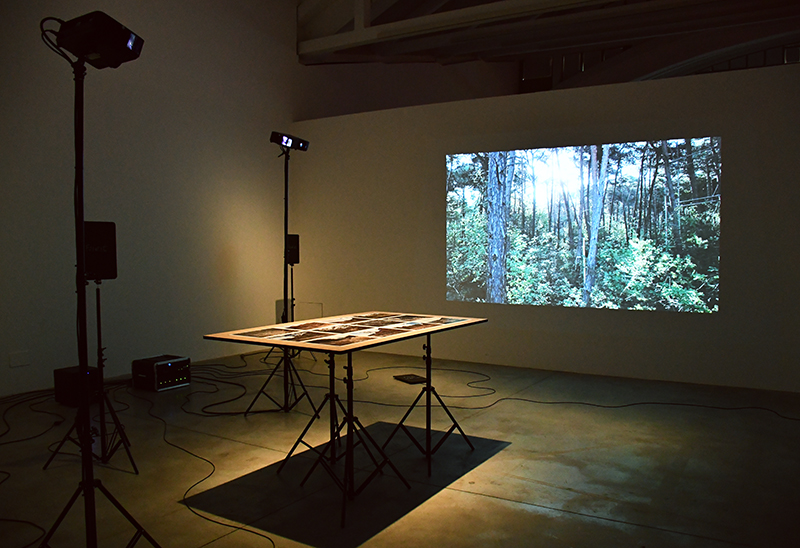
With works by Baggenstos/Rudolf, Ursula Biemann, HeHe, Chris Jordan, Vanessa Lorenzo, Marcus Maeder (Perimeter Pfynwald), AnneMarie Maes, Rasa Smite & Raitis Smits, Aline Veillat a. o.
Laboral Centro de Arte y Creation Industrial, Gijon/Spain
24.5. – 26.10. 2019
Perimeter Pfynwald
A Soundscape Observatory. Marcus Maeder, 2019
The installation “Perimeter Pfynwald” is an acoustic-artistic representation of the ecosystem of a mountain forest in Switzerland. The Pfynwald forest in Valais is already severely exposed to effects of climate change. Due to the mass elevation effect of the Alps, the climatic conditions in the Valais are already very dry. The ever-longer periods of drought and heat are severely damaging the forest: the Scots pines, which make up a large part of the Pfynwald forest, are dying and are being displaced by more robust tree species, including neophytes. It is a climate-induced vegetation change in progress, the progression of which makes it unclear whether the Pfynwald will change from pine to oak and robinia forest in the coming decades or the perimeter will turn into a steppe landscape and the forest in the heart of the Pfyn Nature Park will disappear completely.
The Pfynwald ecosystem can be experienced in the installation in a way that would not normally be possible outdoors in the forest. In the course of the FHNW’s “Ecodata-Ecomedia-Ecoaesthetics” research project, Marcus Maeder distributed several autonomous audio recording devices in the forest, which during the heat summer of 2018 automatically recorded the environmental sounds in the forest, the underwater world in a pond and the sounds of the fauna in the forest floor. In the installation, a soundscape consisting of a temporal and spatial compression can be heard: The recording devices were placed several kilometres apart in the Pfynwald forest and recorded environmental sound at intervals of 10 minutes. In the installation “Perimeter Pfynwald”, different biotopes that lie far apart in a landscape can be heard simultaneously. On the other hand, the interval recordings create a timelapse sound track that reproduces events in the environment in a shorter time than would normally be heard.
A further element of the installation consists of the sonification of environmental measurement data collected by the Swiss Federal Institute for Forest, Snow and Landscape Research (WSL) in Pfynwald as part of its research on forests and climate change. “Perimeter Pfynwald” integrates two microclimatic parameters as artificial sound sources: Measurement data of the air temperature and humidity in the forest control the sound synthesis on the computer of the installation. The result is a sound that is supposed to sound like a voice of the forest. This voice consists of a deep and a high tone – the depth represents the humidity, the height the temperature.
In the installation “Perimeter Pfynwald” it becomes possible to experience how drought and heat have an acoustic effect on the forest in the course of climate change: it becomes quiet. The more intensively the heat and drought period develops in summer 2018, the less can be heard in the individual biotopes: The noise of the nearby river becomes quieter because it carries less water; mountain streams dry up. The fauna retreats, is less active and therefore quieter. The air humidity decreases, the temperature increases, which results in the sound synthesis of the forest voice, that the deeper sound becomes deeper and deeper, the higher one higher and higher, until they lie outside the audible range and the voice silences.
The installation “Perimeter Pfynwald” is a modular and expandable artistic-acoustic observatory in which ecosystems of any size can be examined and represented.
Credits:
Programming: Thomas Peter
Environmental data Pfynwald: Swiss Federal Research Station WSL
Processing and analysis of acoustic data: Martin Rüegg
Perimeter Pfynwald” is part of the research project “Ecodata-Ecomedia-Ecoaesthetics”, funded and supported by:
Swiss National Science Foundation
Institute of Aesthetic Practice and Theory IAeP
Academy of Art and Design FHNW
Zurich University of the Arts ZHdK, Institute for Computer Music and Sound Technology
